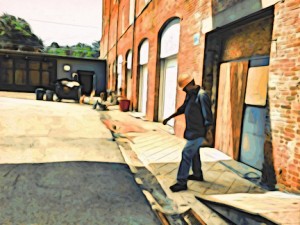I know I’ve kinda built up the idea about myself that I don’t care about medieval warfare, that I consider it an absurd waste of thought. And, well, generally speaking, you’d be right. I think it’s a distraction from the things that actually matter, like actual historical construction methods. I’m interested in how they put things together, not how they broke them.
That being said, some slightly interesting uses were found for ramps in war, specifically for the purposes of siegecraft.
 The first use was actually pre-medieval, though it was used on occasion in medieval times. Siege ramps are huge earthen ramps built right up a castle or city wall, a cliff face, or other positions of strength. They’re about as absurd as you’d think: the builders are going to come under constant attack by the people above, resulting in a wasteful loss of life. It was really only used when the besiegers grossly outnumbered the besieged, were otherwise unable to break through the enemy defenses, and had little care for loss of life on their side. The Romans used it a few times, as did a few of the smaller empires before them, and a few of the smaller kingdoms they conquered.
The first use was actually pre-medieval, though it was used on occasion in medieval times. Siege ramps are huge earthen ramps built right up a castle or city wall, a cliff face, or other positions of strength. They’re about as absurd as you’d think: the builders are going to come under constant attack by the people above, resulting in a wasteful loss of life. It was really only used when the besiegers grossly outnumbered the besieged, were otherwise unable to break through the enemy defenses, and had little care for loss of life on their side. The Romans used it a few times, as did a few of the smaller empires before them, and a few of the smaller kingdoms they conquered.
 The other use was in siege towers. These, at least, were constructed with a bit more safety in mind for the troops on your side: not that sending them over an enemy castle wall is, particularly, a safer idea. Siege towers, depending on the whim of the builder, were generally a bizarre hybrid of ramp, staircase, ladder, and watchtower, all built out of wood and canvas and stuck on wheels to roll right up to the castle walls, where troops could exit the tower directly onto those walls.
The other use was in siege towers. These, at least, were constructed with a bit more safety in mind for the troops on your side: not that sending them over an enemy castle wall is, particularly, a safer idea. Siege towers, depending on the whim of the builder, were generally a bizarre hybrid of ramp, staircase, ladder, and watchtower, all built out of wood and canvas and stuck on wheels to roll right up to the castle walls, where troops could exit the tower directly onto those walls.
They also usually had sheltered positions for archers to fire from. Still absurdly dangerous, of course, but you at least had some shelter from enemy arrows, at least until you got onto the wall. They still were vulnerable to fire, which medieval people loved to use on each other.
All in all: I prefer my ramps for actual construction purposes.